I am posting this how-to article about how to change the fuel filter and fuel pump on '09-'14 Subaru WRX STi's because I could NOT find this info anywhere else on the internet, and this process took me three tries so I hope this is helpful to others.
As a disclaimer, I am not a mechanic. I was trained as a car audio installer, but stuff having to do with the mechanics of a vehicle is outside my comfort zone. At best, I'm a DIY'er, so the process and tools that I used for this install may not be the only way to do this. If you know a better way, that's cool. Also, because we will be working with gasoline, I highly recommend that this job is done outside with proper ventilation! Do not do this during the winter, in your enclosed garage, with the heater running! That being said, let's get started:
First of all, below is the part number for the fuel filter only.
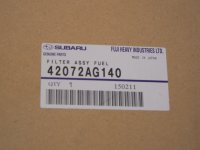
In my experience, this is a difficult part to find because Subaru in all their wisdom chose to do away with the stand alone fuel filter on our model years and made the fuel filter part of the whole fuel pump assembly as you will see in the pictures below. Why they did this, I'm not entirely sure, but I suspect it was to make the process of replacing the filter and pump easier on the parts changers, er, I mean mechanics, at your local Subaru dealer. For us normal folks, this is a pain in the tail, and if you want to do the job yourself the guy or gal at the parts counter will attempt to sell you the entire assembly (including the pump) because this is what pops up in their computer by default. That's great, and would make the job pretty easy, if the whole thing didn't cost $500+. I don't know about you, but changing my fuel filter shouldn't run me $500 in parts. I'd rather put that money toward some go-fast parts! At a minimum, you can replace the filter and the pump with an upgraded pump for less than the whole assembly itself costs (which is what I ultimately did). That being said, you CAN order just the filter! (And all the world rejoiced)
The first step is getting access to the fuel pump assembly, which is located under the rear seat cushion. If you've never removed your rear seat before, start by reaching under each side of the cushion to find these pull tabs:
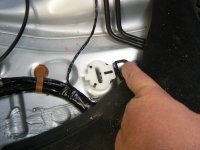
They pull toward the front of the vehicle, and will allow you to release the side of the cushion upward. Once the sides are released, go to the front center of the cushion and just give it a good yank, and the cushion comes out, revealing the metal underneath:

Now this is the area we will be focusing on: the section on the passenger side
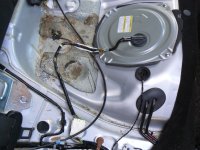
Under this panel is the fuel pump assembly. Remove the four (4) Phillips head screws, and the panel will be loose.
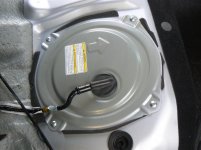
You will not, however, be able to move the panel out of the way much until you loosen the control cables by pulling the cable holder,
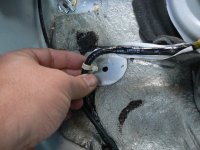
and disconnect the plug close to the passenger rear door sill. This will give you the extra slack you need.
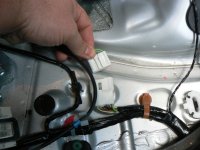
You can then pull the cable and cover panel toward the foot well to get it out of your way. Under that panel you will see the FPA in all it's glory (sarcasm font).

WARNING: From here on out we will be dealing with gasoline and the vapors associated with said gasoline. I again suggest doing this job in a well-ventilated area, you know, so you don't die! I put a fan on the passenger side, behind me, so I was blowing the vapors away from me and toward my neighbor's house. (I don't think they complained...)

Make sure you have some paper towels or rags around to clean up the inevitable fuel spilling that will occur. Gloves are optional, but I used them because I'm a bit of a puss.
I highly suggest removing the eight (8) 8mm nuts to loosen the metal ring that holds the fuel pump assembly down BEFORE disconnecting any of the fuel lines, as this will release the pressure in the system. If you do not do this step, and disconnect the fuel lines first, not only will you get massive leaking of gas from the fuel lines, but the fuel pump assembly connections as well! (Ask me how I know this) A couple of the nuts are under the fuel lines, but they are still accessible. You can also disconnect the plug at the top of the FPA at this time.

Next, you can begin disconnecting the fuel lines by pinching on the clips and pulling the lines loose. They're a tight fit, so it'll take some muscle, but be patient and take your time. The last thing you want to do is break one of these plastic clips. There will be some fuel leaking out of the lines, so be ready with something to soak it up. I took some paper towels and wrapped them around the fuel line ends, and secured them with zip ties just to attempt to limit the spilling out of the lines as I move them around to get them out of my way.

Once all three lines are disconnected, you can gently shove them under the sheet metal to get them out of your way, and remove the metal holding ring.

Then you can grab the entire FPA and slowly pull it out of the tank. It's a tight fit, so go slow.

Be aware that this is a semi-enclosed canister that will have fuel left in it, as you can see here by the dark fluid at the bottom. Be careful not to spill this all over the place, as it will not just drain out as you lift the FPA.

Also, as you remove the fuel pump assembly you will need to tilt the top of the canister toward the front of the vehicle so you don't snag the fuel level float on your way out of the tank.

So here is your $500+ part out of the tank (insert sound of angel's singing here):

To gain access to either the fuel pump, or the fuel filter, we need to remove the bottom of the canister. There are four (4) tabs around the canister that hold it together. Carefully pry these tabs up, and slide the canister section down.

As the canister slides down, disconnect the electrical connection for the fuel level float.

With all the tabs and electrical connections disconnected, the two parts should slide apart. You can set the bottom to the side, as we don't really need it anymore.

Now just dealing with the top section, we have access to the fuel pump and filter, and more hoses than an Imperial Star Fighter pilot.

If you happen to be replacing the fuel filter at this time (and you might as well), you'll find the filter is behind the pump. Here's the assembly and the filter side by side:

The fuel pump is held in place by two clips on the top of the pump. One is easy to find, but one is hidden behind the hoses.

You will need to release these clips to slide the pump out. While I abhor using a flat head screwdriver as a pry tool, it really is the best tool for the job here. I inserted a small flat head screwdriver into the space between the hoses to hold the clip open, and I used another pry tool to release the easy to see clip.

Disconnect the power connection from the top of the pump, and slide it out. Here you can see my new pump side by side with the old pump. Take the o-rings off of the old pump (they may still be stuck up in the plastic of the filter) and place them on the new pump.

If all you are doing is upgrading your pump, just slide the pump up into the filter and reassemble! If you're also replacing the filter, we have a few more steps to go.
Remove the two hoses from the bottom of the filter. (Warning: there will most likely still be fuel in the filter, so be prepared)

Again, make sure you remember to remove the o-rings from the filter, as they will likely not remain on the hoses.

Next, you will need to push down on the springs (why this sucker is spring loaded, I have no idea)

So you can get access to a small, metal clip that holds the filter onto the top of the assembly. Sorry, it's out of focus, but this thing is tiny! Be careful not to break or lose this clip, lest you be really screwed!

Once that clip is removed, the filter will slide right off and everything is as disassembled as it needs to be.

Now you can begin the reassembly process. I'm not going to insult your intelligence by walking you through the steps, since you've gotten this far. Just reverse everything you just did, right?
When reconnecting the hoses to the filter, I suggest putting the o-rings on the hoses first, and lube is your friend since the new filter is dry and will cause the o-rings to stick. Also, when you put the whole assembly back in the vehicle, I would suggest putting the metal ring on the FPA, but do not tighten everything down. Connect your fuel lines, and then secure the nuts that hold the pump in the tank. If you push the pump down with the ring before you connect the fuel lines, the pressure created in the tank will cause fuel to leak out of the fuel line connections (again, ask me how I know this).
Well, I hope this is helpful to everyone. As I said before, I could not find anything on the internet on how this job was done, or especially where in the world to find the frickin' fuel filter! This write up was done over three different installs as I muddled my way through this process, so hopefully this will prevent some of the headaches that I experienced.
Good luck, and if I missed anything, let me know so I can edit the original post.
As a disclaimer, I am not a mechanic. I was trained as a car audio installer, but stuff having to do with the mechanics of a vehicle is outside my comfort zone. At best, I'm a DIY'er, so the process and tools that I used for this install may not be the only way to do this. If you know a better way, that's cool. Also, because we will be working with gasoline, I highly recommend that this job is done outside with proper ventilation! Do not do this during the winter, in your enclosed garage, with the heater running! That being said, let's get started:
First of all, below is the part number for the fuel filter only.

In my experience, this is a difficult part to find because Subaru in all their wisdom chose to do away with the stand alone fuel filter on our model years and made the fuel filter part of the whole fuel pump assembly as you will see in the pictures below. Why they did this, I'm not entirely sure, but I suspect it was to make the process of replacing the filter and pump easier on the parts changers, er, I mean mechanics, at your local Subaru dealer. For us normal folks, this is a pain in the tail, and if you want to do the job yourself the guy or gal at the parts counter will attempt to sell you the entire assembly (including the pump) because this is what pops up in their computer by default. That's great, and would make the job pretty easy, if the whole thing didn't cost $500+. I don't know about you, but changing my fuel filter shouldn't run me $500 in parts. I'd rather put that money toward some go-fast parts! At a minimum, you can replace the filter and the pump with an upgraded pump for less than the whole assembly itself costs (which is what I ultimately did). That being said, you CAN order just the filter! (And all the world rejoiced)
The first step is getting access to the fuel pump assembly, which is located under the rear seat cushion. If you've never removed your rear seat before, start by reaching under each side of the cushion to find these pull tabs:

They pull toward the front of the vehicle, and will allow you to release the side of the cushion upward. Once the sides are released, go to the front center of the cushion and just give it a good yank, and the cushion comes out, revealing the metal underneath:
Now this is the area we will be focusing on: the section on the passenger side

Under this panel is the fuel pump assembly. Remove the four (4) Phillips head screws, and the panel will be loose.

You will not, however, be able to move the panel out of the way much until you loosen the control cables by pulling the cable holder,

and disconnect the plug close to the passenger rear door sill. This will give you the extra slack you need.

You can then pull the cable and cover panel toward the foot well to get it out of your way. Under that panel you will see the FPA in all it's glory (sarcasm font).
WARNING: From here on out we will be dealing with gasoline and the vapors associated with said gasoline. I again suggest doing this job in a well-ventilated area, you know, so you don't die! I put a fan on the passenger side, behind me, so I was blowing the vapors away from me and toward my neighbor's house. (I don't think they complained...)
Make sure you have some paper towels or rags around to clean up the inevitable fuel spilling that will occur. Gloves are optional, but I used them because I'm a bit of a puss.
I highly suggest removing the eight (8) 8mm nuts to loosen the metal ring that holds the fuel pump assembly down BEFORE disconnecting any of the fuel lines, as this will release the pressure in the system. If you do not do this step, and disconnect the fuel lines first, not only will you get massive leaking of gas from the fuel lines, but the fuel pump assembly connections as well! (Ask me how I know this) A couple of the nuts are under the fuel lines, but they are still accessible. You can also disconnect the plug at the top of the FPA at this time.
Next, you can begin disconnecting the fuel lines by pinching on the clips and pulling the lines loose. They're a tight fit, so it'll take some muscle, but be patient and take your time. The last thing you want to do is break one of these plastic clips. There will be some fuel leaking out of the lines, so be ready with something to soak it up. I took some paper towels and wrapped them around the fuel line ends, and secured them with zip ties just to attempt to limit the spilling out of the lines as I move them around to get them out of my way.
Once all three lines are disconnected, you can gently shove them under the sheet metal to get them out of your way, and remove the metal holding ring.
Then you can grab the entire FPA and slowly pull it out of the tank. It's a tight fit, so go slow.
Be aware that this is a semi-enclosed canister that will have fuel left in it, as you can see here by the dark fluid at the bottom. Be careful not to spill this all over the place, as it will not just drain out as you lift the FPA.
Also, as you remove the fuel pump assembly you will need to tilt the top of the canister toward the front of the vehicle so you don't snag the fuel level float on your way out of the tank.
So here is your $500+ part out of the tank (insert sound of angel's singing here):
To gain access to either the fuel pump, or the fuel filter, we need to remove the bottom of the canister. There are four (4) tabs around the canister that hold it together. Carefully pry these tabs up, and slide the canister section down.
As the canister slides down, disconnect the electrical connection for the fuel level float.
With all the tabs and electrical connections disconnected, the two parts should slide apart. You can set the bottom to the side, as we don't really need it anymore.
Now just dealing with the top section, we have access to the fuel pump and filter, and more hoses than an Imperial Star Fighter pilot.
If you happen to be replacing the fuel filter at this time (and you might as well), you'll find the filter is behind the pump. Here's the assembly and the filter side by side:
The fuel pump is held in place by two clips on the top of the pump. One is easy to find, but one is hidden behind the hoses.
You will need to release these clips to slide the pump out. While I abhor using a flat head screwdriver as a pry tool, it really is the best tool for the job here. I inserted a small flat head screwdriver into the space between the hoses to hold the clip open, and I used another pry tool to release the easy to see clip.
Disconnect the power connection from the top of the pump, and slide it out. Here you can see my new pump side by side with the old pump. Take the o-rings off of the old pump (they may still be stuck up in the plastic of the filter) and place them on the new pump.
If all you are doing is upgrading your pump, just slide the pump up into the filter and reassemble! If you're also replacing the filter, we have a few more steps to go.
Remove the two hoses from the bottom of the filter. (Warning: there will most likely still be fuel in the filter, so be prepared)
Again, make sure you remember to remove the o-rings from the filter, as they will likely not remain on the hoses.
Next, you will need to push down on the springs (why this sucker is spring loaded, I have no idea)
So you can get access to a small, metal clip that holds the filter onto the top of the assembly. Sorry, it's out of focus, but this thing is tiny! Be careful not to break or lose this clip, lest you be really screwed!
Once that clip is removed, the filter will slide right off and everything is as disassembled as it needs to be.
Now you can begin the reassembly process. I'm not going to insult your intelligence by walking you through the steps, since you've gotten this far. Just reverse everything you just did, right?
When reconnecting the hoses to the filter, I suggest putting the o-rings on the hoses first, and lube is your friend since the new filter is dry and will cause the o-rings to stick. Also, when you put the whole assembly back in the vehicle, I would suggest putting the metal ring on the FPA, but do not tighten everything down. Connect your fuel lines, and then secure the nuts that hold the pump in the tank. If you push the pump down with the ring before you connect the fuel lines, the pressure created in the tank will cause fuel to leak out of the fuel line connections (again, ask me how I know this).
Well, I hope this is helpful to everyone. As I said before, I could not find anything on the internet on how this job was done, or especially where in the world to find the frickin' fuel filter! This write up was done over three different installs as I muddled my way through this process, so hopefully this will prevent some of the headaches that I experienced.
Good luck, and if I missed anything, let me know so I can edit the original post.
